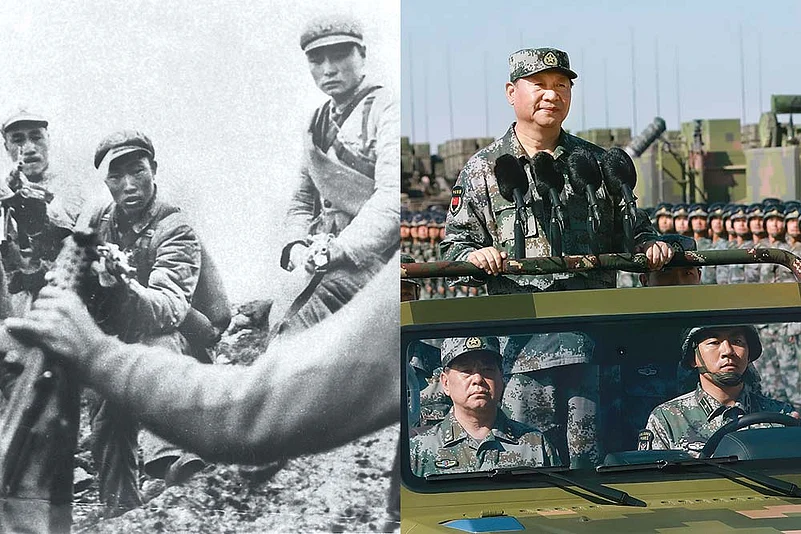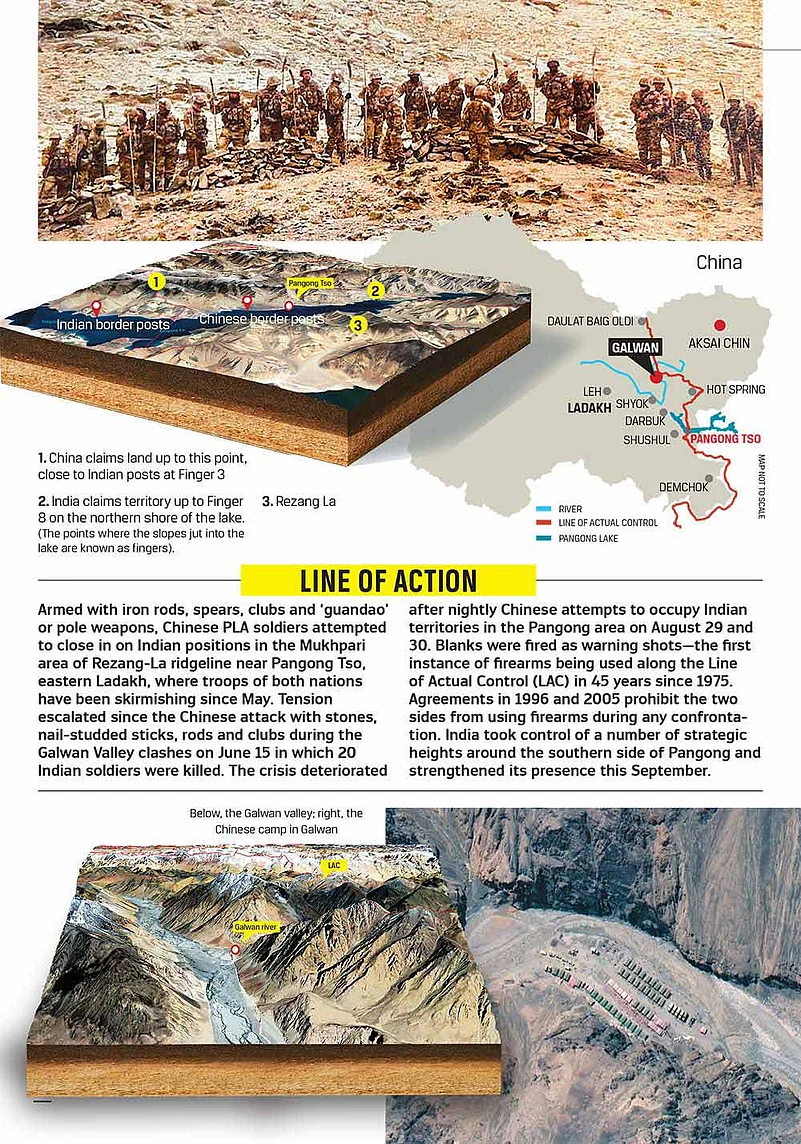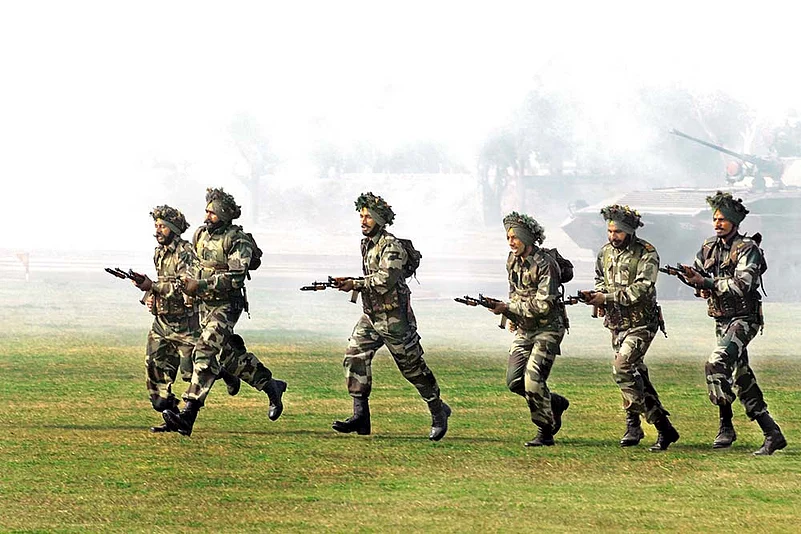Four months of violent face-offs, increasing points of military conflict, intensifying military build-up, banning of 177 Chinese apps, check on Chinese investments by India, and an inconclusive meeting between the defence ministers of India and China on September 4 in Moscow. Is an India-China war inevitable? The question is uppermost in many minds.
1962 Redux?
Isolated in the West, confronted by a pushback in the Indo-Pacific, but driven by overweening entitlement, China might trigger a conflict with India behind a smokescreen of fictional claims. Beijing should know that such an event would imperil all its world-historical objectives.

In statements issued by the two sides, Chinese defence minister General Wei Fenghe, blamed India for the current tension, stating “China’s territory cannot be lost”. India’s stand, articulated by Defence Minister Rajnath Singh, maintained that “Indian troops had always taken a very responsible approach towards border management”. Fundamental to the current impasse is the India-China border being managed based on an un-demarcated line of actual control, with a long-standing unresolved border. China’s military adventurism against India runs parallel to Xi Jinping’s meteoric growth to becoming the paramount power in China. On November 15, 2012, Xi Jinping was appointed general secretary, Chinese Communist Party and chairman, Central Military Commission, and on March 14, 2013, he was appointed president. Within a fortnight, on March 29, 2013, Xi Jinping emphasised on an early resolution of the border issue with India. Eighteen days later, on April 15, 2013, the first protracted face-off bet-ween the Indian Army and the PLA took place in the Depsang area.
ALSO READ: Uneasy Tango Of Big Ambitions
Since then, as Xi Jinping continued to consolidate power, PLA’s conduct on the ground became more and more agg-ressive, violating all the agreements and protocols for peaceful conduct. The strategy adopted has been—force resolution on Chinese terms; intrude, assert, offer negotiations, protract, and push for revising claim lines on the border.
The recent statement of the Chinese Defence Minister is being amplified now through views propagated in the Chinese media on the India-China stand-off. Interestingly, news of the stand-off started appearing in local Mandarin media only after the action on August 29/30. Thus far, even the PLA casualties of the Galwan conflict of June 15 were kept under a veil of sec-recy. Clearly, there is an endeavour to shape public opinion for a potential escalation.

All these opinions are driven by China’s psychological war, and presuppose that India is the aggressor and China the victim. The party line being used to brainwash and create an alternative narrative goes somewhat like this:
First, India is exploiting the deteriorating Sino-US relations to create tensions along the India-China border, thus preventing China from realising cross-strait reunification. Further, there are claims that India and the US are working in collusion; with India triggering China’s western front, and the US activating China’s eastern and southern fronts, thereby posing threat to China on two fronts.
ALSO READ: Do Hold The Horses
Second, India’s actions are orchestrated to justify deployment of US intermediate-range missiles in India. According to Chinese analysts, India is the preferred choice, as China’s geo-graphic proximity to South Korea and Japan makes US assets easily vulnerable to PLA rocket forces.
Third, to break the deadlock in neg-otiations, India is expanding the arc of conflict by opening new points along the LAC, and deploying warships in the South China Sea. Fourth, India’s actions are a smokescreen to distract domestic opinion from the deteriorating Covid pandemic and the weakening economy.
Notwithstanding the Chinese propaganda and psychological warfare, China’s offensive in April-May 2020 could have been prompted by one or more of the following: ?
One, India had recently completed the 255 km DS-DBO road, running along the Shyok River valley, from Darbuk to Daulat Beg Oldie, with work in progress on some laterals going east up to the LAC. Perceiving a threat to Aksai Chin and the highway linking Tibet to Xinjiang, China dec-ided to disrupt India’s infrastructure development and ability to build up.
Two, India’s opposition to Xi’s master project--the Belt and Road Initiative, and China-Pakistan Economic Corridor, followed by the abrogation of Article 370 and notification of Ladakh as a Union Territory, may have added to China’s insecurity and urge to precipitate action.
Three, in 2017, the US unv-eiled its free and open Indo-Pacific strategy. In the following years, the US and its potential partners, Japan, Australia, India, and the ASEAN states have been figuring out their own approach to the Indo-Pacific strategy. For China, restraining US influence assu-med critical importance. Xi Jinping perhaps believed that India could be coerced away from any US-led partnership, grouping or coalition. This was also in line with China’s general aggression, visible in the South and East China Seas, coercion of Taiwan and repression in Hong Kong.

There is no doubt that China had not anticipated India’s rapid mobilisation and the response at Galwan to check Chinese adventurism. Having deadlocked the diplomatic-military talks, China began actively fortifying its positions—constructing bunkers and improving roads, particularly laterals from the highway to the border areas. There are reports of dep-loyment of J-20 stealth fighters, and air defence radars as well.
The Tibet issue, too, has come to the fore now. On August 28-29, at the Seventh Central Symposium on Tibet Work, held in Beijing, Xi Jinping iss-ued orders to “solidify border def-ences in Tibet and ensure frontier security, national security, and enduring peace and stability”. Almost immediately, PLA troops undertook the provocative movement South of Pangong Tso, prompting pre-emptive action by India to secure heights on the southern bank of Pangong Tso.
Having improved its bargaining position, India would like “that neither side should take any further action that could either complicate the situation or escalate matters”. But an imp-ortant border garrison under direct domination of India may be too much for the PLA to make peace with.
Despite the belligerence, the stress on China to garner public support is already showing. On September 7, PLA’s western theatre spokesperson claimed that Indian troops had fired warning shots at advancing PLA troops in South Pangong Tso area. India’s official response dismissed the western theatre command’s statement as an “attempt to mislead domestic and international audience” and emphasised that it was the PLA troops who fired in the air “to intimidate own troops”.
In India’s immediate neighbourhood, China has managed to get Pakistan and Nepal to do its bidding, but in the larger canvas of geopolitics, it is getting inc-reasingly isolated. Besides the US, China’s relations with the UK, Australia, Japan, Canada, Vietnam, and Philippi-nes are becoming adversarial. Even Russia has decided to go ahead with the supply of the S-400 air defence system to India, ignoring China’s concerns. Some of China’s close friends in Europe, too, are turning away.
From August 25 to September 1, China’s Foreign Minister Wang Yi visited Italy, Netherlands, Norway, France, and Germany. The purpose of the visit was to draw Europe away from the United States, strengthen trade ties and set the stage for Xi’s summit with EU head of states. Contrary to his purpose, Wang Yi was rebuked in every country for the draconian National Security Law and postponement of elections in Hong Kong, human rights violations in Xinjiang, and Chinese aggression in the South China Sea. Most telling was the German foreign minister’s statement that the EU would not bec-ome a “plaything” in the Sino-American rivalry.
In the event of a war with India at this juncture, the diplomatic, military, political, economic, and social implications will go much beyond just India-China relations. The very coalitions that China wants to prevent or deter may easily get affected in the event of a war. An ambitious Xi Jinping, who sees himself at the centre of a new era, ‘Rule China, China Rule the World’, may not understand that historically, nations or leaders who began a war hardly ever emerge as winners.
China has not fought a war in over four decades. It is a moot point whether its leadership understands the cost of war, and how much are they ready to sacrifice for their political objectives. In its last war against Vietnam in 1979, though neither side publicised their casualties, the estimates run as high as 28,000 Chinese dead and 43,000 wounded, while the number of Vietnamese dead were estimated at under 10,000.
By resorting to acts short of armed conflict, or what is also called ‘grey zone (neither war nor peace) operations’, China has neither succeeded in thwarting India’s efforts to catch up with infrastructure development in border areas, nor has it added any depth to the BRI, leave alone getting India to see value in China’s vision for a world order “with Chinese characteristics”. If anything, China has given India greater clarity on how it must approach the Indo-Pacific strategy.
China’s arrogance, stemming from its so called comprehensive national power, is dependent on the continuous supply of energy from West Asia. Both its economic and defence potential are contingent on supply of oil. CPEC-Gwadar and other solutions for China’s Malacca dilemma are still some time away. China cannot wish away India’s strategic location and its willingness to make common cause with like-minded nations.

India will manufacture the AK-47 203—an advanced version of the assault rifle—which will replace the Indian Small Arms System (INSAS) 5.56x45 mm gun. An agreement was signed with Russia during defence minister Rajnath Singh’s visit to Moscow this September. The Indian Army requires around 7,70,000 AK-47 203 rifles, of which 1,00,000 will be imported and the rest made in India. The 7.62×39 mm Russian weapon will be produced at Korwa Ordnance Factory in Uttar Pradesh. Each rifle could cost around Rs 81,000. The INSAS rifle, in use since 1996, has issues such as jamming and the magazine cracking at higher altitudes.
Under the circumstances, where China stands internationally isolated, with economy and internal stability challenged, only misplaced hubris could lead China to open two more fronts, India and Tibet, in addition to South China Sea, Taiwan and Hong Kong.
Hopefully, after seeing India’s res-ponse, China understands that despite its overall edge, military and infrastructure put together, India too can concentrate force at the point(s) of effort, at land, sea, and air. In addition, proficiency in high-altitude warfare and combat experience of the Indian soldier, compared to the conscripts of the PLA, makes for a formidable opponent.
For India, the intent now is border resolution. It has recently stated that the border issue cannot be de-linked from trade, investment, and economy. Decoupling of trade relations will have imperatives that India must deal with. India also understands that border resolution requires a political rather than military solution, even as it stands alert and ramps up its military capability.
India, certainly, isn’t keen to escalate the situation. It is in China’s interest to also exercise restraint, but hubris, heg-emony, and expansionist ambition may tempt the Chinese leadership to conti-nue with the offensive. In the current situation created by China, an over-amb-----itious military leader, or even a small spark at the front, could escal-ate the situation. Historically, nations that have been adamantly belligerent and fixated on offensive as a solution rarely concede to pragmatic wisdom, and tip the balance, drawing others? into war.
India must be prepared to face provocation by China across all domains, and should it get drawn into a war, it must be resolute in its response. It would serve India’s interests to treat any such eventuality, as an opportunity to establish its power credentials in the new world order.
***
Reasons why China may consider a limited war with India
- Xi faces domestic criticism after COVID-19 and nosediving ties with US. He needs to shore up his image.
- PLA wants to test its new weapon systems to establish the superiority of Chinese technology, expansion of its arms market
- Beijing is not ready for an offensive in the South China Sea—that means a clash with the US and empowering Trump ahead of polls in the US. If it has to opt for a theatre of war, its western border with India is ideal.
- India battles an economic slowdown; it will start getting new weapons from 2021. China might find this an opportune time.
- Beijing wants to force Nepal, Bangladesh, Myanmar and Sri Lanka to choose sides. It is worried Pakistan would be reluctant to fully participate in a war, as it faces action from FATF, plus political-economic pressures.
- China is concerned about the Quad ministerial meetings and about India adopting a markedly pro-US stance
(The author is a member, National Security Advisory Board, former Deputy Chief of Army Staff and Kashmir Corps Commander. Views expressed are personal.)
- Previous Story
 Elections 2024: Ashok Tanwar Joins Congress Again; Sehwag Endorses Congress Candidate In Haryana
Elections 2024: Ashok Tanwar Joins Congress Again; Sehwag Endorses Congress Candidate In Haryana - Next Story
























